You can’t tell me that birds don’t become “stickier” (more reluctant to fly and easier to approach) when it’s very cold.
For most of the year the Ring-necked Pheasants in my area tend to be nervous and shy. Typically at the approach of a vehicle or a person on foot they’ll skulk in the vegetation or flush explosively. When they do the latter their startling alarm call combined with the incredibly loud whirring of their wings can make one’s heart skip about a half-dozen beats. If you experience it you don’t forget it.
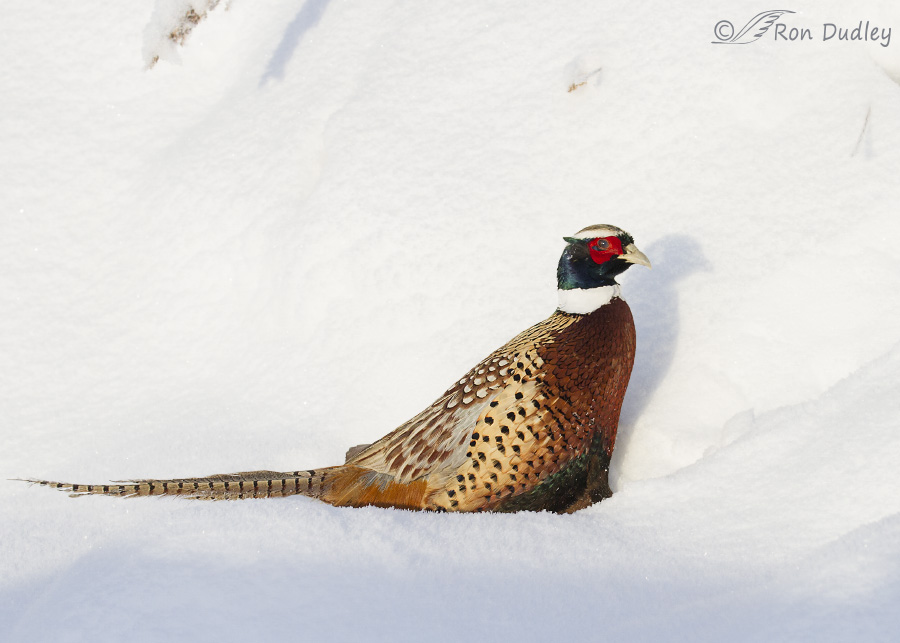
1/1600, f/6.3, ISO 640, Canon 7D, Canon EF 100-400mm f4.5-5.6L IS II USM @ 142mm, not baited, set up or called in
But yesterday morning when I found this male pheasant at Farmington Bay MBA at dawn the temperature was only 5 degrees F. and he had no intention of flying anywhere. He was on the side of a hill facing the rising sun and I believe he wanted to warm up instead of wasting energy on flying. He as right next to the road I was driving and showed little sign of nervousness with me so close (notice that this shot was taken at only 142mm).
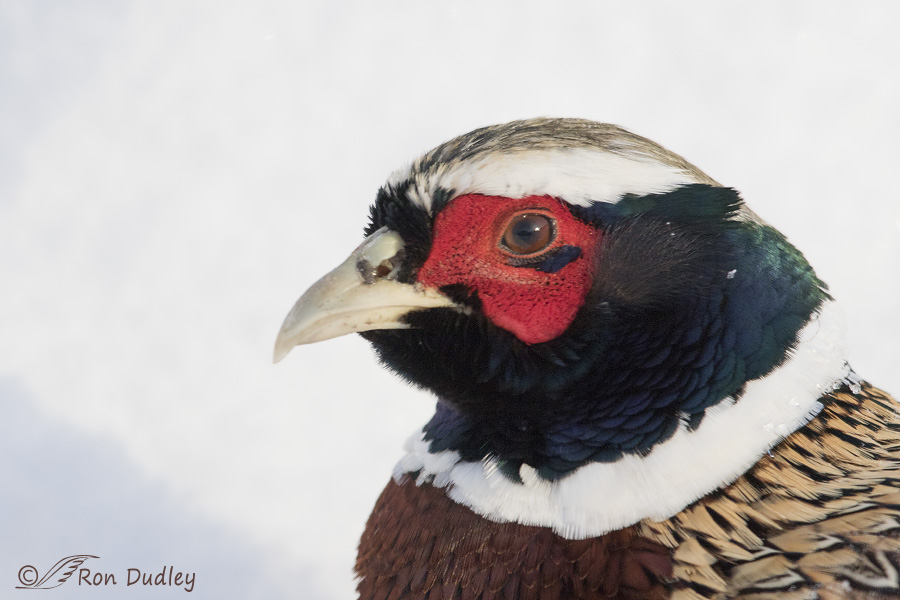
1/1600, f/6.3, ISO 800, Canon 7D Mark II, Canon EF 500mm f/4L IS II USM + 1.4 tc, not baited, set up or called in
To give you an idea just how close, I took this shot with my big lens and it’s full frame (uncropped). In fact I believe I was just an inch or two closer than the minimum focusing distance of my lens because none of these head shots were quite as sharp as they should have been.
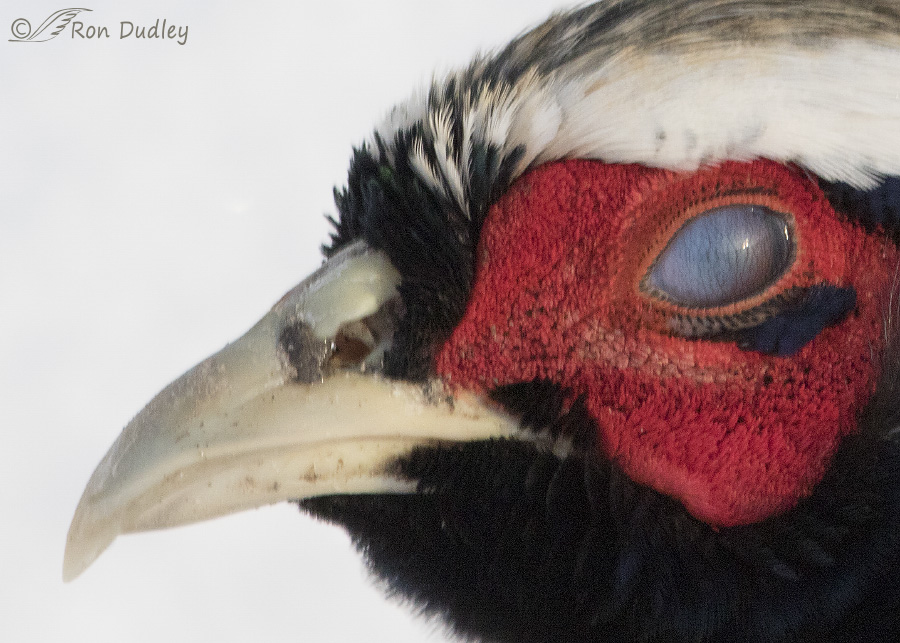
1/1000, f/9, ISO 800, Canon 7D Mark II, Canon EF 500mm f/4L IS II USM + 1.4 tc, not baited, set up or called in
One of those shots caught his nictitating membrane closed and I’m always interested in seeing it up close when I can get this much detail. The membrane is made of living tissue and must be supplied with blood and here we can see its nourishing blood vessels.
The nictitating membrane (nictitans) is a membrane or “third eyelid” found in some vertebrates that can be drawn across the eye for protection and to moisten and lubricate the surface of the eye. It is either translucent or semi-transparent so the animal maintains sight while it covers the eye. Birds, sharks and some reptiles have a fully functional nictitating membrane while in most mammals (including humans) there is only a small vestigial remnant in the inside corner of the eye. However camels, polar bears, seals, aardvarks, marsupials (pouched mammals) and monotremes (egg-laying mammals) do have functional membranes.
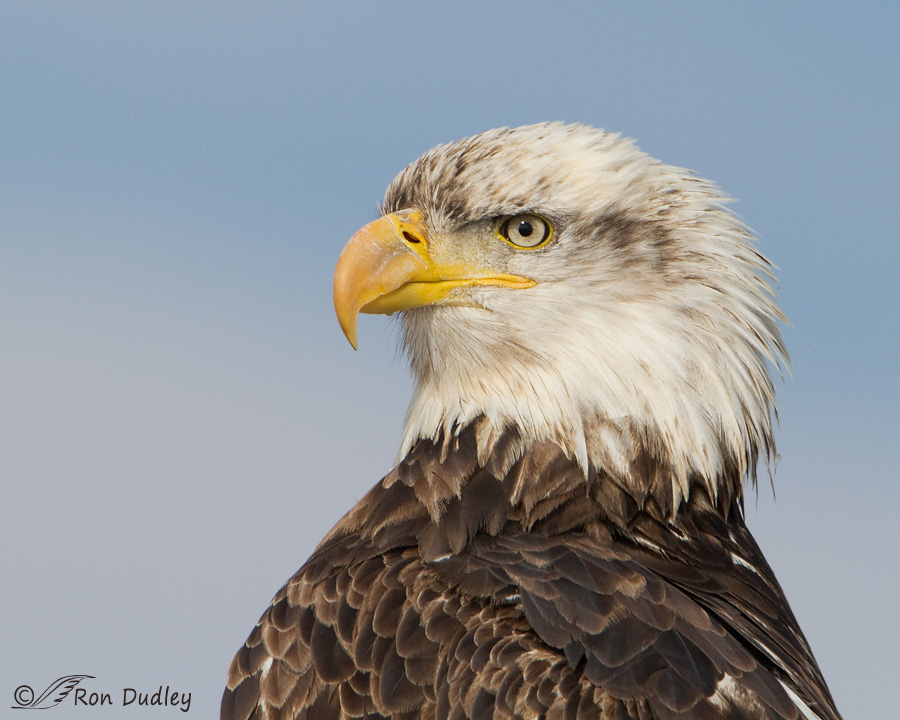
1/2000, f/8, ISO 500, Canon 7D, Canon EF 500mm f/4L IS USM + 1.4 tc, not baited, set up or called in
This impressive near-adult (head not completely white yet) Bald Eagle also gave me a good look at the nictitans several years ago. This bird was unusually tame as it hunted for fish from the “owl bridge” at Farmington. It was perched on the short, thick pole next to the boat ramp (the pole that now has a bat box on it) and the bird simply ignored the occasional traffic directly beneath its position. I froze my behind off as I photographed this eagle for several hours.
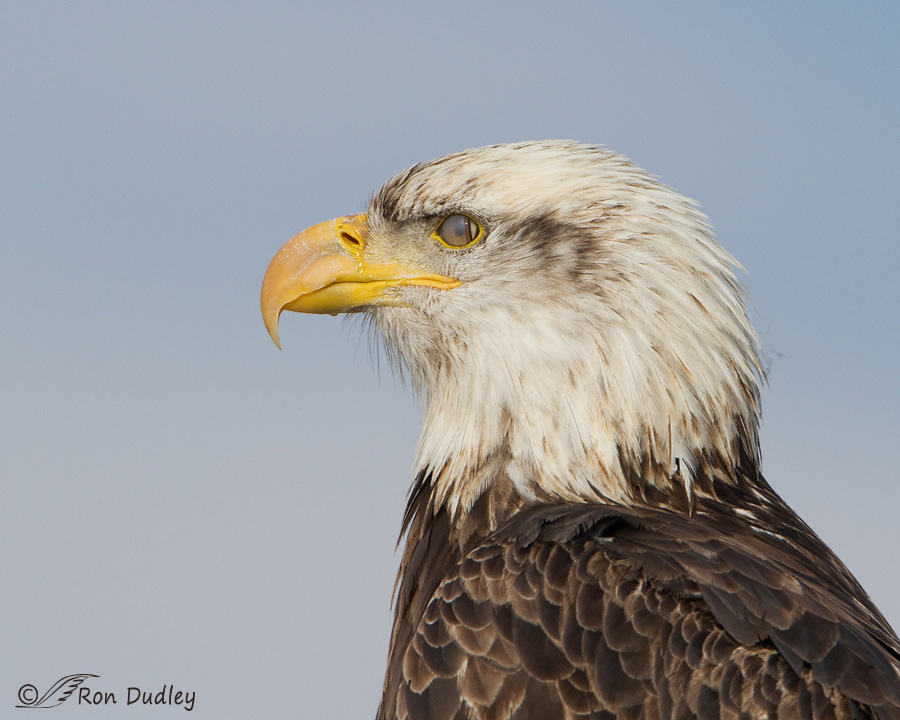
1/2000, f/8, ISO 500, Canon 7D, Canon EF 500mm f/4L IS USM + 1.4 tc, not baited, set up or called in
At one point I caught the membrane partially closed as it swiped across the eye from its inside corner near the beak to its outside corner. In this position the leading edge of the membrane can look like a dark or black vertical line, especially in some bright-eyed ducks like Common Goldeneyes and Lesser Scaups.
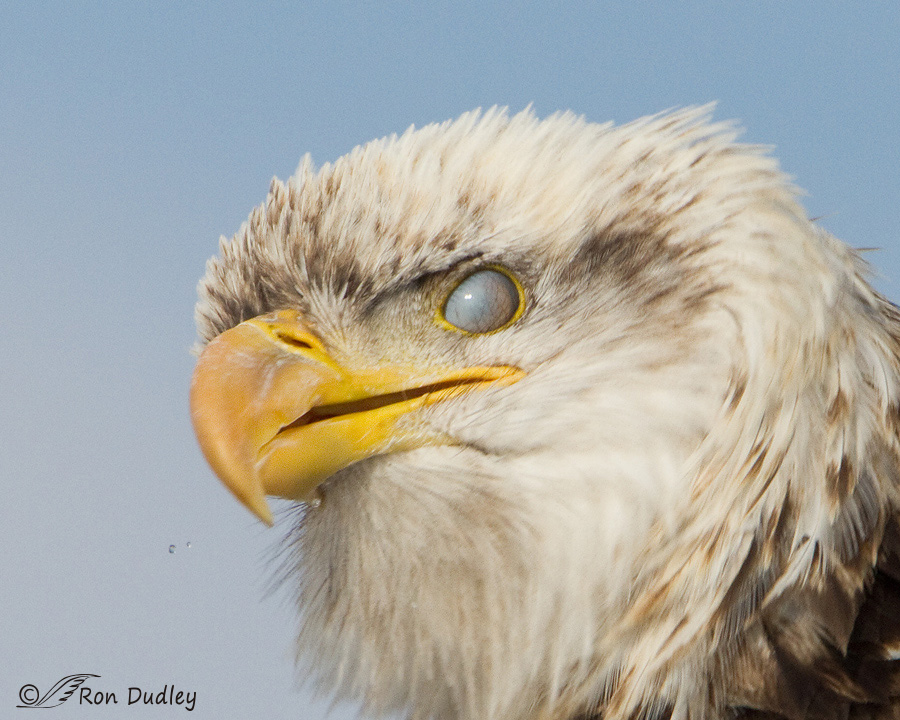
1/3200, f/7.1, ISO 500, Canon 7D, Canon EF 500mm f/4L IS USM + 1.4 tc, not baited, set up or called in
In this image the membrane is completely closed and we get another look at those blood vessels. In this case the eagle closed its membrane to protect its eye as it shook its head, as evidenced by the two flying water droplets and the blurry beak-tip. At some light angles the membrane can look almost opaque like this but the bird can still see through it.
In humans the only remnants we have of the membrane are vestigial but as a biologist I always wonder selection pressures in our evolutionary history caused our ancestors to lose them. There are sure times when I think it would be interesting and even useful to still have them as fully functioning structures.
Ron


Àwsome shots Ron! What an amazing look at how the nictitating membrane works.
Charlotte
Ron, thank you for the information. Terrific photos. I love hearing about how you photographed them, too!
These are very interesting shots. Seeing the nictitating membranes prompts an uncomfortable reaction in me. It makes the birds look blind. They also remind me of the eyes of the old Greek statues, which have always felt weird. Great photos, though. And definitely educational.
“They also remind me of the eyes of the old Greek statues”
You’re absolutely right, Susan. Hadn’t thought of that…
An education and beauty. Again.
Thank you.
Thank you, EC.
Is it possible that humans don’t need the nictitating membranes because we are able to blink our eyes at the same speed we would have closed
a nictitating membrane? Just a thought.
I don’t know the answer to your question for sure, John.
John, that is a good question. My take is that I’m not sure it can be answered for sure.
However, knowing that the DNA code is responsible for our anatomy and that of other protist, bacteria, plant and animals, it would be interesting to see how primate anatomy had changed over millions of years leading to primitive man. We can see how organisms have changed relative to their shape and form; not sure that we can ever be certain about other parts of the body, but an interesting conjecture at any rate.
To check out some of the human DNA changes sign up to the U. of MD MOOC, Genes and evolution at Coursera. I’m only at week 2 and have learned a great deal about our human evolutionary journey. It discusses coding and gene regulation, primate anatomy and other points not known about DNA and it’s actions when I got my BS in 1970.
That nictitating membrane question should be answered in our DNA. That might be covered in the course.
Pam
Many thanks Pam. Interesting! It is absolutely fascinating what has been learned and the advances that have been made since Watson and Crick!!
Thanks, Pam. I graduated in Biology that same year!
What wonderful examples and biology lesson from my arm chair this morning. Thank you, Ron. Stay warm.
Thanks, John. Just got back from a morning of shooting and my feet are still cold. Warming them up now…
Very interesting post! I hadn’t thought about nictitating membranes needing blood vessels. So interesting to see them. As to why we don’t have them – I sometimes think we give evolution more credit for deliberate progress than we should. It would certainly help a mammal predator to have these devices, when they are struggling with a feathered or prickly prey item or dashing through brush. We primates have hands and so don’t need them. But if mammals had them and lost them, they might well have been linked in the mammal DNA with some other structures that were lost or changed. Color vision is something that apparently mammals lost (rather than not developing) as they were developing as largely nocturnal creatures. Primates have more color cone types than other mammals (we have three). Diurnal birds and reptiles of course have more still (four to five). And I’m sure color cones are expensive in energy. But again, those changes may have been linked to many changes in development between diurnal and nocturnal life styles. Owls and most other nocturnal and crepuscular birds have fewer color cone types and many many more rods, for light-gathering. My two cents . . .
“We primates have hands and so don’t need them”
Sallie, I believe that some of the “lower” primates, including lemurs, do have functional membranes – but you’re right, the rest don’t.
I thought your “two cents” were interesting, thank you.
Intetesting images…bring back some memories. Our Grackle, Jack, used to flash his nictitating membrane just before pecking the heck out of me. He did this whenever I yelled at one of the kids or brushed my palms together. With four active kids and lliking to garden, I took a lot of abuse! He was my buddy the rest of the time…Pheasants used to make my heart stop when I walked the fields…I never saw them until they “exploded” out of the tall grass just under my nose….I almost stepped on them first!!!…..
That must be a pretty young eagle, judging by all the brown still in the head feathers….although the eye color is light for a young bird…kind of confusing!….y
Patty, if I remember correctly some birds like magpies flash their membranes as a form of communication. Sounds like your grackle might have been doing the same thing. I believe the eagle was in its fifth year, almost an adult.
That pheasant is gorgeous. The shots of the nictitating membrane were very interesting!
Thank you, Arwen.
I become “stickier” too if we have weather like that, like I stick to the fire and blanket. Of course here the roads would be impassable. Interesting article, and beautiful image of the pheasant, they are such pretty birds.
Thanks for the chuckle, Jo. And for the nice words about the image and the article.
Great shots as usual, Ron.
I have always wondered whether changes within animals we call evolution isn’t more the product of use and disuse. If you are attacking and eating something that could thrash around your head and injure your eye it wouldn’t take long for evolution to favor (select) those animals who have a nictitating membrane that favors that protection. Then later in time when changes in an animals eating habits doesn’t need that same protection that membrane would take a back seat to other selection pressures affecting that species.
Very interesting stuff!!
“I have always wondered whether changes within animals we call evolution isn’t more the product of use and disuse.”
Your comment brought back memories of some of the history of the development of evolutionary theory, Dick – things like Lamarck’s old “Law of Use and Disuse” and the classic example of how the giraffe developed its long neck.
But I don’t think there’s any question that if an organism wastes energy and resources on an organ or trait that is useless to it, that fact puts those individuals with that trait at an evolutionary disadvantage. It makes sense that those individuals with the trait would be slightly less likely to survive and pass the genes for the trait to the next generation. Over time the trait would be lost and/or modified.
Obviously it’s more complicated than that with lots of nuances but still interesting to think about at that level.
Ah yes, you said it well!!
I should have used some genetic terminology as well, which Lamarck didn’t do.
use and disuse is important in evolution
thanks, of course for the biology lesson and the shots of the nictitating membrane in different positions. i wonder how muh our visual acuity would be compromised with an adaption like this? birds many framewss per second might compensate for reduced acuitity. I am human doc not a biologist like you but I wonder often what we have lost and gained through evolution.
It certainly would be compromised to some extent, Diana but then if we had it the membrane could be opened at will and very quickly so I’m really not sure why we (our ancestors) lost it.
I had seen this before, but wasn’t sure exactly why this was present. Thank you for explaining it in such good detail accompanied by excellent photos.
Good, Zaphir – I’m glad this post was informative for you. Thanks.
Interesting! Know our cats have them tho I’ve never seen them completely closed so, as you noted, may not be able to. Birds do try to conserve energy in the cold tho the pheasants that come in the yard for a little grain and to surf under the bird feeders in winter are still VERY spooky. Does make your heart go pitter pat when they flush even when I’ve experienced it may times. Nice work!
Nice work!
Judy, If I remember correctly the membrane in cats is usually only visible when they’re sick or not doing well for some reason, though there are manipulative techniques that vets and others use to cause the membrane to become more visible.
It usually is only visible when they aren’t well in my experience tho in the case of one cat we had it was out fairly often and he was fine. Vet posited that he’d been very ill when younger and that was a leftover.
Wonderful shots. I loved seeing both the eagle and the pheasant – I am from Minnesota but now being in Florida; we do not see a lot of pheasants in the sunshine state!
Merry Christmas to you and your family.
Linda
Thank you, Linda. Merry Christmas to you too.
Ron, your head shots of both Pheasant and Bald Eagle are amazing. It’s nice to get these kinds of rewards for freezing your butt off!! LOL!! Enjoyed the whole series and again, didn’t see the water droplets off the eagle’s beak until I read your commentary!! When WILL I learn to look more closely – sigh!! I looked back at the photo and realized I was too busy looking at the eagle’s nictitating membrane!!
Jo Ann, don’t feel badly for missing details like that. It’s easier for me to spot them because during processing I have to pay very close attention to the image.